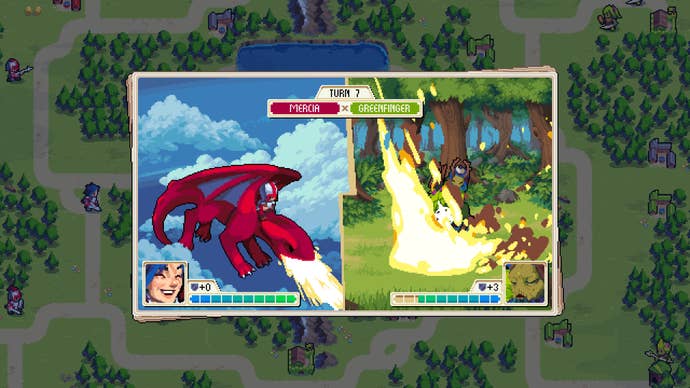Wargroove Review
Chucklefish Games repurposes a classic tactics formula while throwing in a few tricks of its own. Our full review.
This article first appeared on USgamer, a partner publication of VG247. Some content, such as this article, has been migrated to VG247 for posterity after USgamer's closure - but it has not been edited or further vetted by the VG247 team.
I owe the original Advance Wars a lot. When I started playing it back in 2004, I found tactics games intimidating. For a girl reared on arcade games and platformers, overhead grids felt alien and overwhelming.
With its cartoony graphics, power-ups, and distinct characters, it gently eased me into a genre I wound up loving. It proved a gateway to XCOM, Final Fantasy Tactics, and many other wonderful games. Sadly, Advance Wars has been missing in action for more than a decade now, and Intelligent Systems seems unlikely to pick up the series again anytime soon.
Thankfully, indie developers are once again here to grab the baton and give their own spin to a venerable series. Like Stardew Valley was inspired by Harvest Moon, Chucklefish's Wargroove is essentially Advance Wars, but with mages and dragons rather than tanks and airplanes. It has much the same whimsical sense of humor as Advance Wars, downplaying the horrors of war in favor of the hijinks of vampire batgirls, and a similar artstyle as well—2D sprites on a map intercut with short battle animations.
From a gameplay perspective, it may remind some of the turn-based strategy of Fire Emblem, the more famous of the two Intelligent Systems tactics games, but there's a crucial difference. Instead of recruiting individual characters and trying to keep them alive, you produce them from factories and send them off to battle to serve as frontline cannon fodder. The only unit that truly matters is your hero unit, who is not only extremely powerful, but can power up a special ability that aids your entire army.
Battles play out in turns on large maps dotted with houses, which can be captured for additional income. Battle lines form naturally from captured territory, and from there success becomes dependent on positioning units to take advantage of Wargroove's rock-paper-scissors system of hard counters. While mages, spearmen, and battlepups (yes, Wargroove has armored puppers) mix it up on the frontlines, trebuchets and archers rain down damage from afar. Units like dragons are expensive, but if you work it right, you can basically do an end-around the enemy army and take out its headquarters before they can stop you.
I often find myself side eyeing tactics games that rely too heavily on hard counters, mostly because it limits flexibility, but Wargroove's units offer enough layers that it never feels too rigid. It mostly means that you can't rely too heavily on any one unit, as it can be rapidly nuked out of existence by the right counter. Medium tank swarms don't exist in Wargroove in the same way as in Advance Wars.

Wargroove's tactics find their greatest expression in the Arcade Mode, where you pick one of a dozen commanders and try to win five successive battles. With both sides starting on even footing, battles move at a rapid clip, and it's much easier to find a quick solution (like the aforementioned dragon end-around). The same can be said for Puzzle Mode, where you take a pre-determined mix of units and try to win the map in a single turn.
I'm less of a fan of the actual campaign, which is both slow-paced and very, very difficult. Later missions take a solid 45 minutes to an hour to complete, and with no ability to manually save in the middle of a mission (Wargroove auto-saves if you quit out), you have little room for error. Missions usually give the enemy faction a large advantage, so with a few exceptions, they tend to play out the same way each time—rope-a-dope until you have a large enough army before snowballing toward your opponent's headquarters.
The story is thin as you expect from a game like this. War breaks out after a vampire assassin murders a king, sending his daughter Mercia on the run and in search of allies. Her quest sends her through the lands of the various factions—the Night Elf-like Floran Tribes, the desert-dwelling Heavensong Empire—where she often finds herself in battle against otherwise friendly factions owing to a misunderstanding.
Between missions, you're treated to some character development as Mercia mourns her father and comes to grips with being a queen. But for the most part it adheres to well-worn fantasy tropes, the brief cutscenes offering few opportunities for meaningful character interactions outside of the ones that drive the plot forward. The best bits of conversation are when Sigrid is lazily taunting you during one of the hardest missions in the game, which sees you frantically trying to keep Mercia alive amid a swarm of enemy units.

The campaign is obviously Wargroove's centerpiece, so it's unfortunate that it's a bit of a slog. If it really bores you, though, Arcade and Puzzle Mode are both faster-paced alternatives that stand up very well on their own. The campaign's slow pace is further offset by a wealth of customization options, including sliders that let you turn damage way down while turning income way up, as well as the ability to turn off battle animations (something I did immediately).
If these options still aren't doing it for you, you can just create your own. Wargroove's best feature, the element that really sets it apart from its illustrious predecessor, is its suite of creation tools. Wargroove has not just a comprehensive map editor, but a full-blown campaign editor in which you can string together multiple missions. You can even make your own cutscenes.
It's admittedly a little unwieldy on Switch, but having these tools available on both console and PC is really impressive. They've been touted as the same set of tools used by the developers, and based on the sheer breadth of options available, I believe it. Add in the ability to easily share and download them online, and you can expect to find a basically unlimited number of high-quality missions long after the campaign comes to an end.
It's a pretty comprehensive package all told, making it easy enough to recommend to tactics fans. Still, I should warn you: it really is that hard. I will cop to having to significantly turn down damage just to get through the aforementioned mission with Mercia, which had me zigging up and down through narrow channels on a massive map while being harassed by hordes of enemy units. Advance Wars was also very tough in its day, but Wargroove has been kind of straight-up kicking my ass.
In a weird way, though, I suppose that reflects how far I've come since first picking up Advance Wars. Once upon a time, I probably would have fled a challenge like Wargroove and never looked back. These days, I relish the feeling of a strategy coming off perfectly and opening up the entire map. Wargroove may not quite surpass Advance Wars in the same way that Stardew Valley transcended Harvest Moon, but it still does a good job of repurposing the original formula in a way that feels fresh and interesting. And with Advance Wars unlikely to ever return, that will hopefully be enough to capture a whole new generation of tactics fans.
ConclusionWargroove takes a classic formula and repurposes it for a more traditional swords-and-sorcery fantasy setting (with battlepups). With its large number of modes and impressive suite of creation tools, it's almost enough to fill the Advance Wars-sized hole in our heart.












